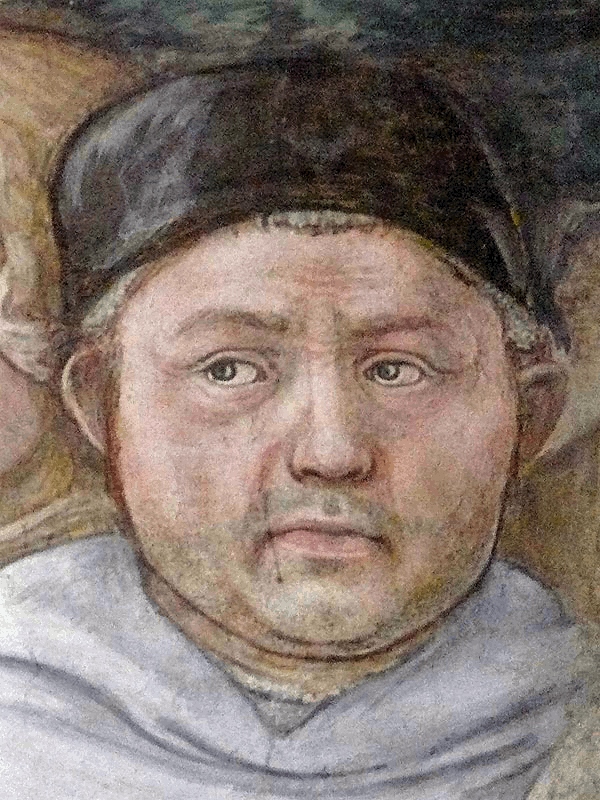|
FILIPPO LIPPI
|

Filippo Lippi, Public domain
Self portrait - 1452
|
- Fra Filippo Lippi (1406-1469) and was the product of Florence’s intense artistic culture during the
Italian Renaissance and the reign of the Medici family.
- Also known as Lippo Lippi, he was born in Florence, Italy,
to a butcher named Tommaso Lippi and when he was 2 years old, he was
left orphaned after the death of his father.
- He then lived with his aunt, who eventually placed him in Santa Maria del Carmine’s convent after being unable to afford to take care of him
- At age 16 in 1421, he took vows as a Carmelite friar, for
which he was wholly unsuited, and that is what the
title 'Fra' stands for.
- While he fulfilled his duties, he was a philanderer and generally considered a troublemaker.
- Filippo had a son named Filippino Lippi
(1457-1504) who was also very accomplished.
|
Although Lippi was a man with a murky reputation, he was able to climb the church ranks. In 1425, Lippi became promoted to a priest. Staying within the ranks of the church provided him access to various works of art and gave him a place to live and work. In 1432, he quit the monastery to travel and paint. Despite quitting, he was not released from his vows.
(thecollector.com)
|
|

Fraught with problems
|
- Filippo enjoyed the patronage of Cosimo de’ Medici, and the support of Florence’s most powerful family proved crucial to the artist, whose personal and business lives were fraught with problems.
- After Filippo had been appointed chaplain of a convent
in nearby Prato, he began a long relationship with one of its
residents, Lucrezia Buti, a Catholic nun, after he 'abducted' her
from the convent.
- This affair sparked controversy within the church, causing many other members to break their vows and cohabitate.
-
Lucrezia was the model for several of his Madonnas.
- The two lived together openly between 1456 and 1458
in his home and had a son, Filippino,
and later a daughter, Alessandra.
-
Due to the help of the Lorenzo de' Medici, the pope dissolved Lippi and Buti’s vows.
- The two may or may not have married; some sources claim that Lippi died beforehand.
|
Filippo Lippi was the modern-day equivalent to a playboy. He had many affairs and mistresses, although as a monk his vows prohibited him from doing such. Giorgio Vasari went as far as to say, “[He] was so lustful that he would give anything to enjoy a woman he wanted if he thought he could have his way; and if he couldn’t buy what he wanted, then he would cool his passion by painting her portrait and reasoning with himself.” While working for Cosimo de’ Medici, Medici confined Lippi to his room to ensure he would work. However, this did not stop Lippi. He escaped, taking a multi-day break to relieve himself of his carnal needs.
(thecollector.com)
|
|

Protective custody
|
- The scandal was compounded by civil complaints because patrons claimed that Flilppo did not fulfill his contracts, and an assistant accused him of withholding wages.
- At one point, he was tortured on the rack.
- Finally, with help from
Lorenzo de' Medici and the humanist pope Pius II, Filippo was allowed to leave his order.
- He and Lucrezia married and had one more child, a daughter,
although some claim the two never married because he died.
- After he left the priestly order, Filippo continued to
sign his work 'Frater' which means brother.
|
Even the Medici had difficulties with the artist, once holding him in “protective custody” within the palace so Filippo would complete a commission. He escaped.
(nga.gov)
|
|

Productive worshop
|
- All the while, Filippo maintained one of the two busiest workshops in Florence and enjoyed high regard as an artist.
-
His application of color and experimentation with naturalism allowed for a new way of viewing religious imagery.
- Filippo trained his son and Botticelli and took on major
commissions in Florence and elsewhere and a large number of
his 75 or so paintings and frescos survive.
- Lippi died around October 8,
1469, at the age of 63 and the circumstances of his death are
generally unknown, although Vasari suggested poisoning.
-
Some even suspected that Lucrezia's family poisoned him for
impregnating her and ruining her reputation.
- Lorenzo Medici commissioned Lippi’s son, Filippino Lippi, to design his father’s marble tomb.
|
He was an early Renaissance master of a painting
workshop, who taught many painters. Sandro Botticelli
and Francesco di Pesello (called Pesellino) were among
his most distinguished pupils. His son, Filippino
Lippi, also studied under him and assisted in some
late works.
(Wikipedia)
|
|
|
The world and life's too big to pass for a dream..
Robert Browning, Fra Lippo Lippi

|

